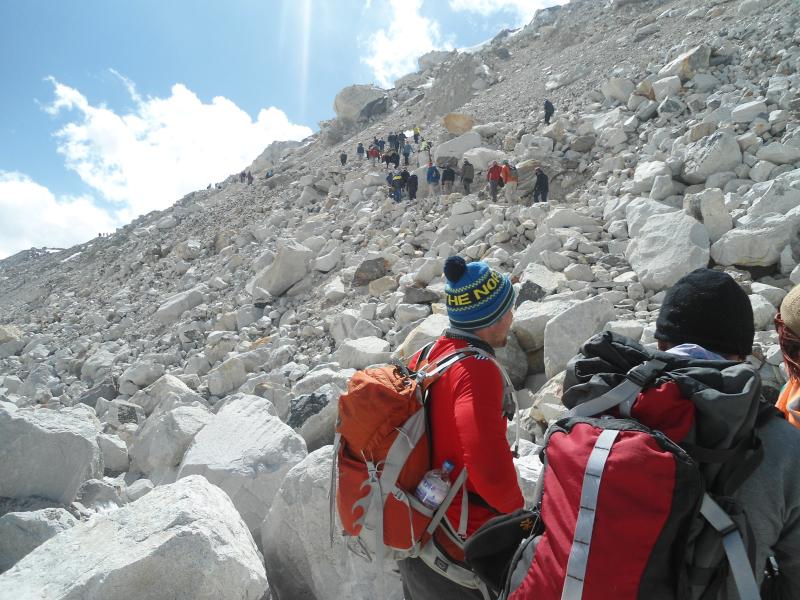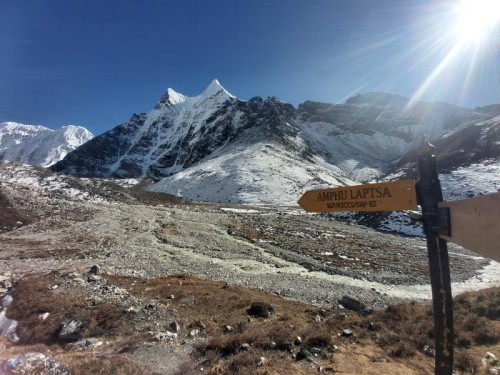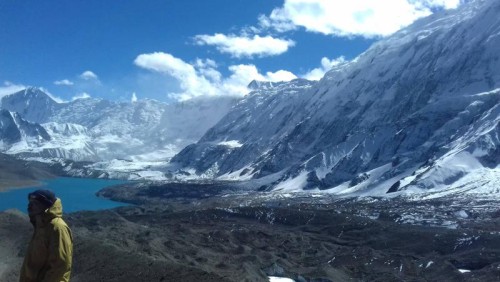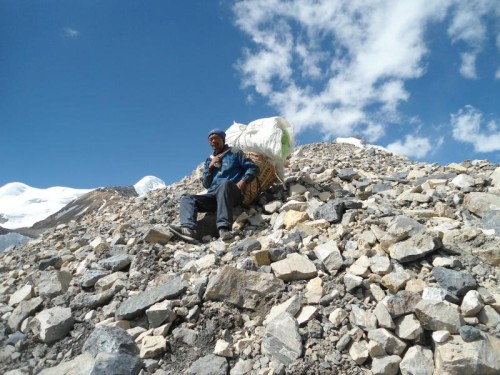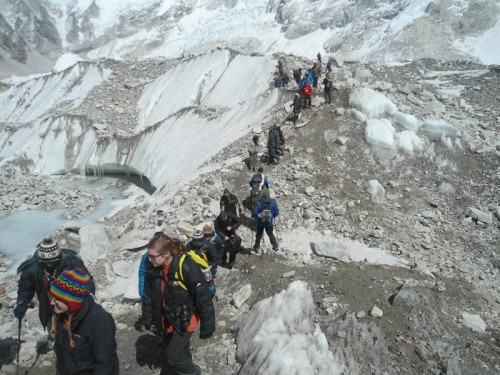Makalu Sherpani Col Pass Trek Location
The Makalu Sherpani Col Pass Trek is located in the Makalu-Barun National Park and Sagarmatha National Park in northeastern Nepal, within the Sankhuwasabha and Solu Khumbu Districts. The starting point of the trek is Tumlingtar, which can be reached by a flight from Kathmandu. The trek takes you through one of the most remote and least explored regions of Nepal, in the surrounding area of Mount Makalu (8,485 meters), the fifth-highest mountain in the world. The route leads toward Makalu Base Camp and crosses the challenging high-altitude passes of Sherpani Col, West Col, and Amphu Labtsa, eventually connecting with the Everest region. The trek ends at Lukla, where you will take a flight back to Kathmandu.
Difficulties during the Makalu Sherpani Col Pass Trek
Makalu Sherpani Col Pass Trek is considered a highly challenging trek that demands a combination of physical fitness, technical skills, and the ability to manage remote and challenging landscapes. This trek requires professional guides who are familiar with the route and can provide necessary guidance and support in any difficulties.
The difficulties related with this trek are given below:
High Altitude: The trek involves reaching high altitudes; with the Sherpani Col Pass itself situated at around 6,112 meters (20052 feet) and other high passes. Altitude sickness is a significant concern, and trekkers must be prepared for symptoms such as headaches, nausea, and fatigue. Proper acclimatization is essential to reduce these risks.
Technical Climbing: Crossing the Sherpani Col Pass and others passes requires some technical climbing skills. Trekkers might need to use climbing gear such as ropes, crampons, and ice axes to navigate steep slopes and crevasses. Previous mountaineering experience or training in basic climbing techniques is beneficial for this trek.
Extreme Weather: Weather conditions in high-altitude environments can be harsh and changeable. Trekkers should be prepared for sudden changes in weather, including snowstorms and freezing temperatures.
Remote Landscape: The trek takes you through remote and isolated areas with limited facilities. Accommodation and food options are basic, and trekkers need to be self-sufficient and prepared for rough conditions. Mostly we have to bring everything from the city such as tents, utensils, food and climbing equipment due to remote terrain. The trek requires specialized gear like crampons, harnesses, and ice axes for safe passage over technical sections.
Long Duration: The Makalu Sherpani Col Pass Trek is a long trek that usually takes around 20 to 25 days. The extended duration adds to the physical and mental challenges, requiring stamina and determination.
Physical Fitness: Excellent physical fitness is necessary due to the demanding nature of the trek. Trekkers will be walking for several hours a day, often on rough and challenging terrain.
Acclimatization day to reduce the Altitude Sickness for the Trek
An acclimatization day is necessary during the 21-day Makalu Sherpani Col Pass Trek because it traverses remote areas and high-altitude terrain, particularly from Makalu Base Camp to Chukkung, which involves crossing passes that exceed 5,500 to 6,000 meters in elevation.
The trek starts at 1,000 meters in Tumlingtar and gradually climbs to over 6,000 meters, passing through small villages and forests while crossing high-altitude areas. As you ascend, oxygen levels and air pressure decrease compared to sea level. Once you reach an altitude above 3,500 meters, you may experience symptoms of altitude sickness, such as nausea, vomiting, diarrhea, headaches, loss of appetite, fatigue, dizziness, and insomnia.
Both Khongma and Makalu Base Camp are designated as acclimatization rest days in the itinerary for the Makalu Sherpani Col Pass Trek. These rest days help prevent altitude sickness and allow you to adapt to the environment. If you experience any symptoms of altitude sickness during the trek, it is important to address them immediately to avoid difficulties in completing the trek and climb. To prevent these issues, you should follow your guide's instructions, as they are knowledgeable about high-altitude sickness
When ascending on the 3,500 meters, be honest with your guide about how you are feeling. Your guide will advise you to walk slowly and may suggest that you sleep at a lower altitude before ascending further. This practice, known as acclimatization, helps reduce the risk of altitude sickness.
To prevent altitude sickness, you should follow the itinerary closely, as proper acclimatization helps your body adapt to higher elevations. Additionally, stay hydrated by drinking plenty of water, eat a well-balanced diet with sufficient carbohydrates, maintain a comfortable pace, and avoid alcohol and sedatives. By adhering to these guidelines, you can reduce the risk of altitude sickness and have a safer and more enjoyable trek on the Makalu Sherpani Col Pass Trek. However, if you continue to feel unwell despite following these recommendations, you should return to a lower altitude.
Risk area during the Sherpani Col Pass Trek
Trekking from Sherpani Col Base Camp to Amphu Lapcha North Base Camp is undeniably a high-risk undertaking due to the technical nature of the route, the extreme altitude, lack of teahouse accommodations, the need for tent camps at high elevations, and challenging weather conditions. It is essential to have mountaineering skills, proper preparation, and a professional team to tackle this section safely. If you're not experienced in high-altitude, technical treks, it’s advisable to reconsider or opt for an experienced guide who can safely lead you through the dangers of this route.
The route involves crossing glaciers, snowfields, and rocky sections, with some areas requiring the use of ice axes, crampons, and ropes (especially on ice or snow). The terrain can be steep and exposed, with loose rocks and ice making the trail hazardous, particularly during winter or spring when snow and ice are more prevalent. This section reaches extreme altitudes, pushing trekkers up to around 6,000 meters (19,685 feet). The lack of oxygen at these altitudes increases the risk of altitude sickness and complications like HAPE (High Altitude Pulmonary Edema) and HACE (High Altitude Cerebral Edema).
Weather in the high Himalayas can change abruptly, making the passes more dangerous. Snowstorms, fog, high winds, and extreme cold can reduce visibility and make it difficult to navigate the route. While the passes are not as demanding as technical climbs, they still require mountaineering skills such as ice climbing, crevasse crossing, and the use of technical equipment like ropes, harnesses, and carabiners. For inexperienced trekkers, these sections pose a significant safety risk, as they may not have the skills or equipment necessary to navigate these technical areas safely.
This area is quite remote, and in case of an emergency, such as an injury or altitude sickness, it can take several hours to days to get help, especially when crossing Sherpani Col or West Col. Helicopter evacuation can be difficult due to weather conditions, and there is no immediate access to hospitals or clinics.
The entire section requires trekkers to be in excellent physical condition to handle long and strenuous days of trekking in such harsh environments. Climbing Sherpani Col and Amphu Lapcha Pass itself is physically demanding, with snow, ice, and high winds adding additional challenges. The climbing difficulty can vary depending on the time of year, snow conditions, and weather.
There are no teahouses or regular accommodation options along the route, so trekkers must carry all their supplies, including food, water, and camping equipment. This adds extra weight and requires careful planning for resupplies. Depending on your itinerary, it could take multiple days to cross these sections, with the only accommodation being camping or basic trekking huts. The route passes through glacier sections where crevasses can be hidden beneath snow or ice. A fall into a crevasse is a significant risk, requiring knowledge of crevasse rescue techniques and preparation for potentially hazardous glacier conditions.
Best time Trek to Makalu Sherpani Col Pass
While many trekking agencies promote the autumn (September to November) and spring (March to May) as the best seasons for the Makalu Sherpani Col Pass Trek, based on our experience, these periods are not always ideal due to the high altitude and extreme weather conditions. The trek involves crossing three high passes, each over 5500 to 6000 meters, where snow accumulation during March to mid-April and in November can make the route very difficult to navigate. Heavy snow can obscure paths, increasing the challenge of crossing the passes, making the trek more strenuous and potentially dangerous during these months. In such cases, it becomes harder to find the correct path, and navigating through snow-covered trails makes the trek far more challenging.
Spring (Pre-Monsoon):- March to May
Spring is the best time for the Makalu Sherpani Col Pass Trek due to the mild weather, clear skies, and blooming landscapes.
During this season, you can expect:
- Warmer temperatures, especially at lower altitudes, make trekking more comfortable.
- Clear visibility, offering panoramic views of the surrounding mountains
- Rhododendron and other wildflowers in full bloom, adding vibrant colors to the landscape
- Lower chances of rain and snow, reducing the risk of weather-related disruptions
Autumn (Post-Monsoon):- September to November
Autumn is another excellent time for Makalu Sherpani Col trek, as the monsoon rains have cleared, leaving behind clear skies and crisp air.
This season offers:
- Stable weather conditions with minimal rainfall, ensuring clear views of the mountains.
- Pleasant temperatures, making trekking during the day comfortable and nights relatively warmer
- Dry trails and less mud, making the trekking experience more enjoyable
- Festivals and cultural events in local villages that provide insight into the local culture
It is important to know the best month for challenging trek, April, May, September and November are best months for this Makalu Sherpani Col Trek. As such, it's recommended to trek during these most favorable months to minimize risks related with weather, altitude, and overall trail conditions.
Before starting Makalu Sherpani Col Pass the trek, always need to check the most up-to-date weather forecasts and trail conditions. Trekkers need to choose a reputable trekking company for adventure trekking and hiring experienced guides who are familiar with the area and its challenges.
Require Permits for the Makalu Sherpani Col Pass Trek
The Makalu Sherpani Col Pass trekking route is situated within the Makalu Barun National Park and Sagarmatha National Park in the Makalu and Everest regions of Nepal. This trek ends at the Khumbu Pasang Lhamu Rural Municipality, so you need to purchase entrance permits for both Makalu Barun and Sagarmatha National Parks, as well as the Khumbu Pasang Lhamu Rural Municipality entrance fee. Another required permit is the TIMS (Trekkers Information Management System) card, which is for your safety and security, as it helps keep track of trekkers' whereabouts in the region. All permits are mandatory for the Makalu Sherpani Col Pass Trek.
These permits obtained from a reputable trekking company through the Tourism Board (Bhrikuti Mandap). You or your guide must carry these permits throughout the trek, as you need to show them and register at every checkpoint along the trail. If you attempt to trek without these permits, you will need to purchase them on-site at double the cost (as a penalty), or you may be forced to turn back.
TIMS (Trekkers Information Management System) Card:
- Cost: US$ 20 per person, per trek
Makalu Barun National Park Entrance Fees:
- Cost: US$ 30 per person, per trek for all foreigners
- Cost: US$ 15 per person for SAARC (South Asian Association for Regional Cooperation) citizens
Khumbu Pasang Lhamu Rural Municipality entrance permits
- Cost: US$ 30 per person, per trek for all foreigners
- Cost: US$ 20 per person for SAARC (South Asian Association for Regional Cooperation) citizens
Sagarmatha National Park Entrance Fees:
- Cost: US$ 30 per person, per trek for all foreigners
- Cost: US$ 15 per person for SAARC (South Asian Association for Regional Cooperation) citizens
Trekking Gear List
Travel equipment is necessary to pack before you travel. We hope it is too much to carry from your home to another country but some of the necessary equipment can hire or buy in Kathmandu around Thamel. This general equipment is for all seasons while on trekking in Nepal, but may be different as per the different season and duration of trekking routes on your chosen trip.
Documents:
- Passport and 4 passport size photos
- Travel insurance details (in case an emergency evacuation if needed)
- Boarding passes for flights
- Driver’s license (if needed)
- Cash USD
- Credit/Debit Card (Ensure you have $500 on your card incase an emergency helicopter evacuation is needed)
Sleeping:
- Sleeping bag (Comfort rating -15 Celsius recommended)
- Sleeping bag liner (Optional)
Footwear:
- Trekking boots: one pair lightweight
- Sandals for city and tea house footwear
- Shoes for the plane and tea houses (Optional)
- Gaiters for hiking in winter to the base camp
- Thin, lightweight inner socks
- Thick, warm wool hiking socks
Clothing for Body:
Please make sure that you have non-cotton clothing for trekking:
- Base-layer t-shirts (e.g. running t-shirts)
- Fleece/Windproof jacket
- Waterproof jacket
- Down jacket for warmth
- Travel clothes and City Wear
- Underwear
- Base-layer trousers (optional)
- Waterproof trousers
- Trekking trousers
- Trekking shorts (Optional)
- Gloves and wool hat
- Bandanna or scarf
Health Requirements (Basic First Aid Kit)
- First-aid kit; should contain lip salve, Aspirin, Band Aids, antihistamine, Imodium or similar tablets for mild cases of diarrhea
- Rehydration powder, extra prescription drugs you may be taking if any particular
- Wet wipes for cleaning can be purchased in Kathmandu
Others:
- Sunglasses and Sun cream
- Towel
- Book (reading and writing materials)
- MP-3 /Music, headphones and ear plug (who know some people on group are snoring) as
- Travel wash
- Hand sanitizer, wet wipes
- A day bag: 35 liters
- A duffel or rucksack with straps to go over your back (Max 12 kg of weight for porters to carry)
- Dry Liner or Dry Bag
- Water bottle/thermos/ camel bag: At least 2 L. Nalgene bottles best.
General Toiletries
- Toilet papers/ tissue
- Contact lenses, Glasses (if needed)
- 1 medium sized quick drying towel
- Tooth brush/paste (preferably biodegradable)
- Multipurpose soaps (preferably biodegradable)
- Large plastic bags – for keeping items dry inside your kit / duffel bag
- Travel games i.e. chess, backgammon, and scrabble. (for luxuries)
- Binoculars (for luxuries)
- Trail Map/Guide book (if you are alone)


